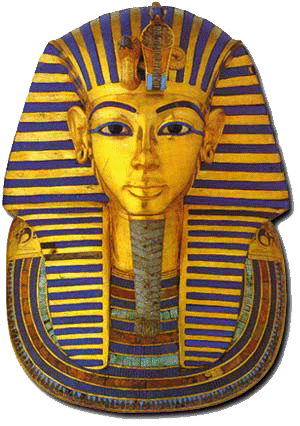
INTRODUCTION
The government of Ancient Egypt was theocratic. In ancient times, the priest were the actual governors of the empire, not the Pharaoh. The priests were the powers-that-be behind the scenes. They placed the king on his throne and maintained him there by their priestly influence, and it was the priesthood that protected him during his reign. The priests' political power also included their vote in the election of leaders. The temples were the sanctuaries of the Letters and Sciences, and learning in all its branches was cultivated exclusively by the priesthood.
Unlike today, where most knowledge is a common right for all to participate (up to their intellectual capacity), in ancient Egypt learning was regarded as a high privilege, and education was under the direction of a small group of priests who were Initiates into the Sacred Mysteries of Ancient Egypt. These priests were organized into the Mystery Schools or sacred State institutions, and they were united by bonds, pledges and vows of secrecy. Such was the power, knowledge and secrecy of the Ancient Egyptian priesthood.
To enter the Mystery School and become an Initiate to the Ancient Sacred Mysteries of The Priests of Egypt, one had to be recommended by one of the Initiates. Application was NOT considered. Every member had to be sponsored by an Initiate in good standing. The sponsor would then become the student's guardian, guide and mentor. Once the person had been recommended, the king (Pharaoh) then gave the official authorization for their initiation. Only the highly privileged were granted the honor to become an Initiate into the Ancient Sacred Mysteries.
Pythagoras, the great Greek philosopher, apparently applied in vain for admission but was repeated denied. It was only after many YEARS of waiting and preparation that he was finally ELECTED into the Mystery School. (It must have been of profound importance to him because he spent 22 YEARS of his life in Egypt to learn these secrets.)
Plato, Thales, Solon and Aristotle also received Initiation into the Sacred Mysteries before returning to their own country. After Initiation, Plato returned to Greece and founded a distinguished system of thinking and deep learning, knowledge he had learned in Egypt. (Whatever it was he learned in Egypt must have had a profound influence on him.)
Not all priests were initiated into the Mysteries though. Only a small mumber of them received the great secrets of their order. For those who did not belong to this Brotherhood, rite and ritual sufficed. It should be mentioned that there were women Initiates, too. Women Initiates were High Priestesses.
WHAT IS INITIATION
"The purpose of Initiation is a conventional attempt to realize man's place in the universe and in the divine scheme of things, and this, I believe, the Eyptptian Mystical System achieved for the first time in an orderly and philosophical manner..." - Lewis Spence
"To the Initiated of the sanctuary, no doubt, was reserved the knowledge of the god in the abstract, the god concealed in the unfathomable depths of his own essence. But for the less refined, adoration of the people were presented the endless images of deities sculptured on the walls of the tmeples." - Alphonse Mariette
As Egyptologists study the ancient Egyptian people and their culture, it appears they (and the rest of us) fall under the "less refined" group, as Alphonse Mariette states. We seem to be content to gaze upon the outer forms of the divinities (gods) sculpted on the walls of the temples, yet never think to understand that broad mystical concept of life of which these ancient gods were but the outer semblance and concrete symbol of. Their figures represented so much more than just their sculpted form.
The Egyptian priests taught a doctrine of metaphysics that appealed to the highest aspirations of Man, and they kept it a secret, never to be revealed to the people but under fables and allegories (ie. Osiris and Isis).
Imagine that.
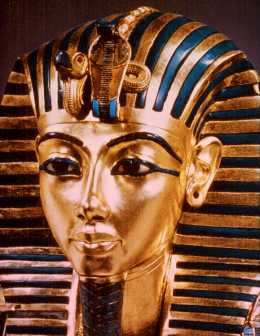
THE URAEUS
CROWN
u•rae•us (yoo re'as) n. a representation of the sacred asp upon the headdress of rulers of Ancient Egypt, symbolizing supreme power
Uraeus is a Greek word to describe a fiery cobra rearing up. In ancient Egypt, this serpent figure was attached to the front of a headdress/crown as an ornament, protruding from the forehead, above the brow, and worn by divinities and sovereigns. It was an emblem of "supreme power," reserved for divine royalty and diety. History books tell us it was believed to be a protective symbol that protected the king from all evil by spitting fire upon his enemies. They also tell us it is associated with the goddess Wadjet and Isis and bla, bla, bla...
I'm not going to spend a lot of words repeating what you can read in high school history books. Over the course of time, several interpretations and meanings of the uraeus crown have evolved. What I want to do here is reveal an interpretation of this sacred symbol that the history books do NOT discuss. Why? Because what mainstream historians cannot understand, they avoid. Why? Maybe they are too old to learn something new. Or maybe they don't have the intellectual capacity (to learn) something that is beyond anything they have ever thought or studied. Or maybe they are just too lazy to do the research, content to repeat what earlier historians have already concluded. Or maybe they just don't want to think outside the box of their job security.
In any case, thoroughout history, the snake/serpent/cobra symbolized:
• transformation
and evolution
• the unconscious
• rejuvination and healing
• rebirth
• psychic energy
• rain
• fertility
• tempatation
• satan
• sex
• phallus
• sin (Christianity)
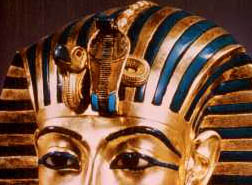 |
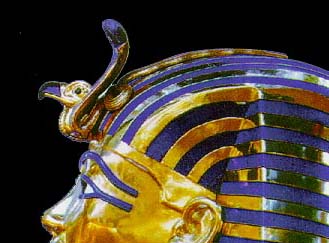 |
The uraeus crown was the symbol of true Initiation - symbol of an Initiate. The band of gold (crown) with a cobra rearing up from the forehaed was a symbol of procreative energy of life, which had been transformed and spiritualized. It was an insignia of the majestic position of a High Priest or High Priestess.
There was a time long before King Tutankhamen wore the uraeus crown when the King and the High Priest were one and the same person. He was the earthly and spiritual leader of the people. But as Egypt grew in culture and wealth, the tasks were divided up and a separation of duties followed; The Pharaoh ruled over the stately affairs and the High Priest fulfilled the duties of the Temple as guardian of knowledge in every field.
Fast Forward: Many years later, Egypt fell into decline. Under the Ptolemies came the dissipation of the sacred arcana and the violation of the sanctuaries of the Hermetic Gods. When this happened, the members of the secret schools separated and the priests retired into the Arabian desert and journeyed to different parts of the world, taking with them the old doctrines. When the sacred arana left Egypt, the original, true purpose/meaning/symbol of the uraeus crown went with it, and new symbolic meanings found their way into the history books. It was during these later years that the Egyptian kings and queens inherited the uraeus headdress as a traditional symbol of their great royal power and authority, not knowing that the crown they now wore was not the symbolic crown of an Initiate but simply costume jewelry.
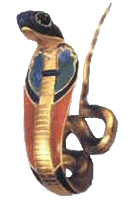
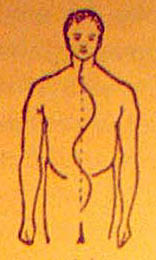
The original uraeus (rearing cobra) represented the Divine Fire in the human body (spiritual energy) "rearing up" the spinal cord, through the chakra system, eventually activating the pituitary gland, or "Third Eye," which is located above the brow between your eyes, exactly where the uraeus is attached to the crown. (The snake in the human body is the spine, and the spine is an important nervous center and carrier of spiritual energy, known as Kundalini.)
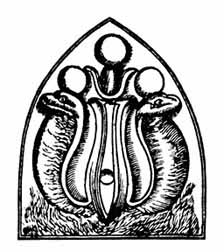
It has been said that the Third Eye is a direct doorway to your subconscious (unconscious) mind. The headdress with the cobra head protruding from the forehead exemplifies this symbology.
When the Third Eye chakra is awakened, the person may see waking visions, places, and people as clairvoyance is a byproduct of this chakra. In ancient Egypt, the "INITIATE" who wore the uraeus crown possessed these abilities and other occult powers.
But Initiation
had a price.
Above:
Uraeus drawing from
Kircher's Oedipus AEgyptiacus
|
BACK |
LEARN |